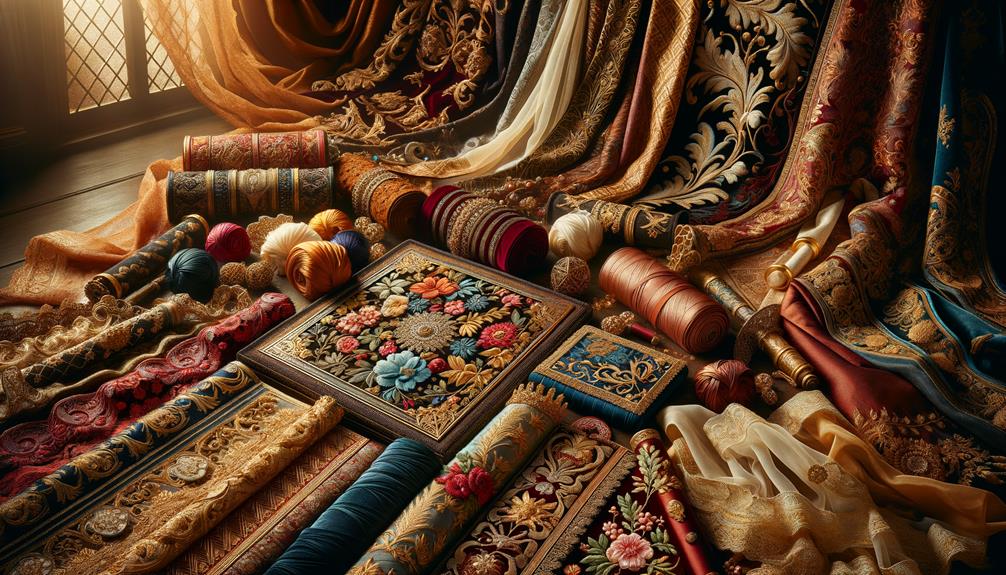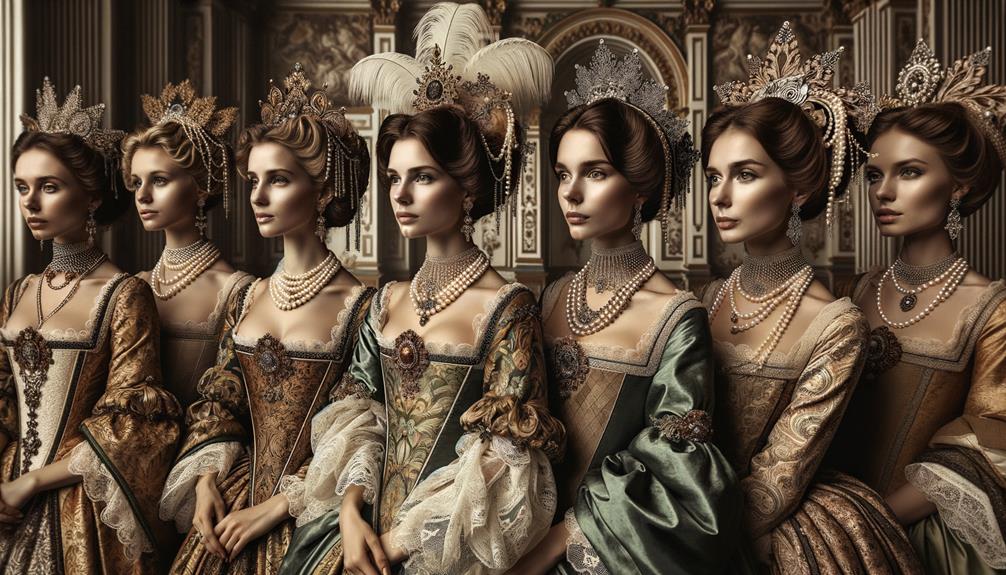Renaissance men's fashion was all about refined opulence and making bold social statements. They draped themselves in luxurious silks and velvet, fabrics that directly reflected their social status. Vibrant and intricate embroidery transformed their attire into art. Doublets and jerkins, layered with precision, showcased their dedication to elegance. The codpiece, once practical, became a bold symbol of masculinity. Accessories like perfumed gloves and jewel-encrusted caps whispered tales of affluence. Even footwear carried a silent weight of style and substance. If you want to learn more, there's so much more hidden in these historical garments.
Luxurious Fabrics
Draped in silk and velvet, Renaissance men's fashion was a clear indicator of social status. I've always been fascinated by how fabric choice could convey a person's standing in society. During the Italian Renaissance, the wealthy showcased their status with garments made from the finest silks and satins. These materials weren't just about comfort or luxury – they were statements of power and prestige.
Looking at portraits from the period, I can almost feel the sumptuous textures. Nobles and royalty wrapped themselves in intricate brocade patterns, each thread reflecting their wealth. Velvet coats, often quilted and heavily embellished, were more than just clothing – they were symbols of power and prestige. It's intriguing how something as simple as fabric could convey so much about a person's position in society.
In contrast, the middle class and peasants wore practical fabrics like wool and linen. Cotton, flannel, and leather served everyday needs, highlighting the stark contrasts within society. This disparity in fabric choice underscores an era where material possessions were closely tied to identity.
The Italian Renaissance not only transformed art and culture but also the very fabric of society. Clothing was more than just fashion – it was a language of status and aspiration.
Embroidery Techniques
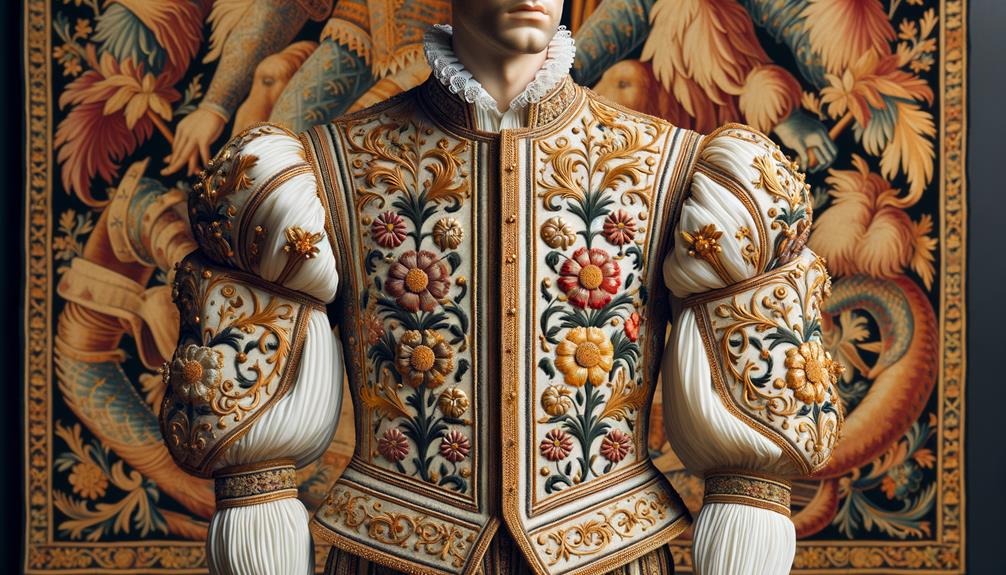
I often find myself marveling at the intricate stitching patterns that adorned Renaissance men's clothing. The vibrant colors of the threads brought the designs to life, telling a story of craftsmanship and attention to detail. Each piece was a testament to the skill of the artisans who created them, showcasing their mastery of embroidery techniques.
Intricate Stitching Patterns
In the midst of Renaissance men's fashion, intricate stitching patterns brought garments to life. Embroidery wasn't merely decorative; it reflected status and wealth. Each stitch on a doublet or jerkin told a story of meticulous craftsmanship. Satin stitch, chain stitch, stem stitch – these techniques transformed simple fabric into works of art.
I'm drawn to the delicate floral designs, heraldic symbols, and geometric patterns that adorned these garments. Silk, gold thread, and pearls were more than materials; they were tools in the hands of skilled artisans who elevated men's attire to new heights of opulence. Every piece was a statement, visually representing one's place in society.
These embroidered garments, often passed down as heirlooms, were more than just clothes. They were treasured possessions, encapsulating generations of wealth and tradition. The fine details, stitched with precision, showcased the artistic flair and dedication of skilled hands. Innovations in embroidery techniques reflected a commitment to beauty and perfection.
Looking at these patterns, I see more than fabric and thread. I see a legacy of craftsmanship, a demonstration of the human desire to create and innovate. The Renaissance period, through its intricate stitching, reminds us of the timeless pursuit of elegance and excellence.
Colorful Thread Choices
The vibrant hues of colorful threads brought Renaissance garments to life, each shade chosen with care and purpose. I often marvel at how these threads transformed simple fabrics into masterpieces. Embroidery wasn't just decoration; it was a statement of identity.
Men's doublets and jerkins featured elaborate floral motifs and detailed designs, with gold and silver threads woven through the fabric, shimmering with every movement. These metallic hues signified wealth and status. I can't help but think about the meticulous effort artisans invested in each piece, creating patterns that were both intricate and bold.
Vibrant threads played a significant role in the visual impact of these garments. Deep reds, lush greens, and rich blues added layers of depth and complexity to the embroidery. Every stitch was deliberate, reflecting the wearer's attention to detail and place in society.
For those who crave innovation, Renaissance techniques offer valuable lessons in blending artistry with purpose. They remind us that true innovation often lies in the details, in the thoughtful choices that turn the ordinary into the extraordinary.
Symbolic Codpieces
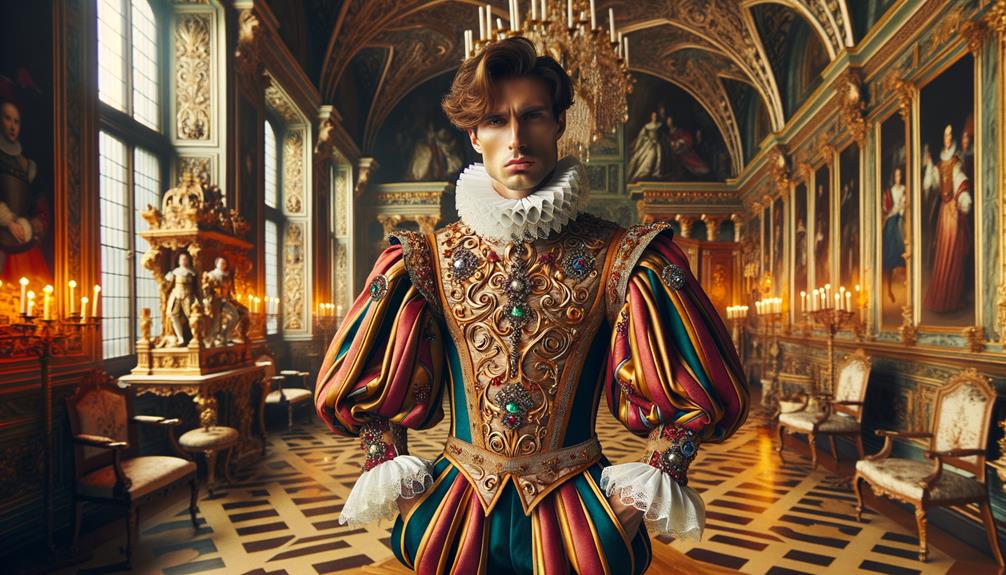
I find codpieces fascinating – they started as a practical solution but soon became a status symbol of masculinity and power. The way they evolved reveals a lot about Renaissance society and what it meant to be a man. It's remarkable how a small piece of clothing could hold so much social significance.
Historical Significance
Codpieces emerged as powerful symbols of masculinity and power, evolving from simple coverings to lavish displays of status. At first, they served a practical purpose, but as the Renaissance unfolded, they became much more. Observing their evolution, I notice how they began to signify not just a man's virility but his social standing. Intricately designed, these ornate accessories caught the eye in both paintings and sculptures of the era.
In the 16th century, codpieces evolved into prominent fashion statements. Their decorative elements reflected the societal norms and masculine ideals of the time, encapsulating the essence of Renaissance men's fashion. These pieces were more than just garments; they were declarations of identity and ambition.
As I delve into the historical significance, it becomes clear that codpieces played a crucial role in shaping the visual language of the period. They weren't merely functional items but symbols that spoke volumes about one's place in society. The elaborate details and craftsmanship behind each codpiece reveal a culture deeply invested in appearances and status, making them a fascinating study in the interplay between fashion, power, and identity.
Social Implications
Many people saw symbolic codpieces as bold declarations of masculinity and social rank. These accessories weren't just functional; they made a statement. In the 16th century, ornate codpieces evolved from simple coverings to elaborate symbols of power and virility. Imagine walking into a room, codpiece gleaming with intricate designs, instantly marking you as someone of significance and influence. It's fascinating how a piece of clothing could speak volumes about one's place in society.
I think it's interesting how the evolution of codpieces mirrored the Renaissance itself – an era obsessed with the human form and the projection of power. These accessories became more than just fashion; they were tools of social distinction. The more elaborate the codpiece, the higher the status. Men wore them like badges of honor, their designs signaling wealth and dominance.
Fashion, as such, played a significant role in shaping social identities. Codpieces encapsulated the Renaissance spirit, blending art with attire. They weren't merely decorative; they conveyed a message, each one a reflection of the wearer's place in the social hierarchy. Codpieces, hence, played a crucial role in the narrative of men's fashion and societal roles.
Doublets and Jerkin
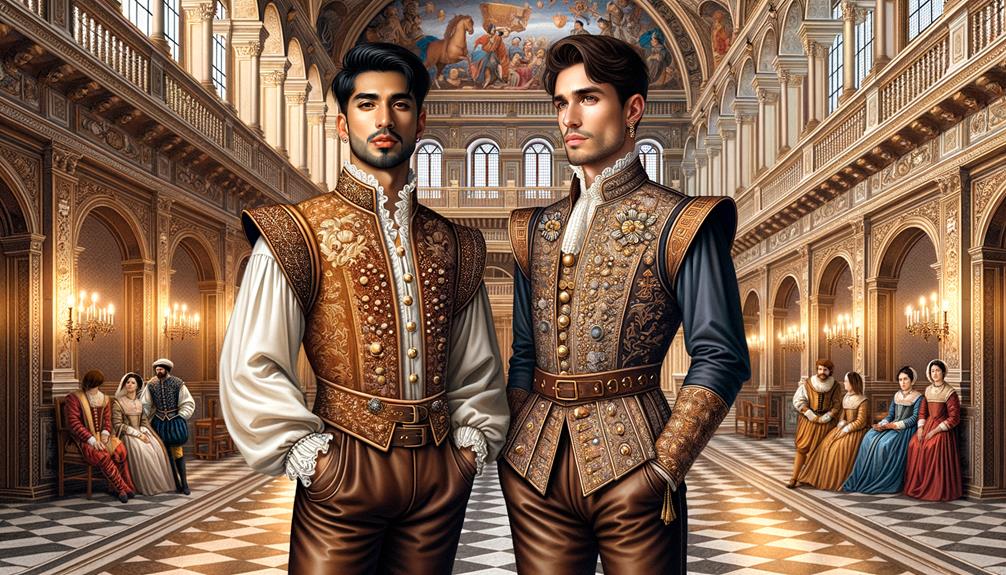
Exploring the intricate designs and luxurious fabrics of doublets and jerkins reveals the Renaissance man's dedication to elegance and sophistication.
The doublet, often laced with precision, was more than just a fitted jacket. It was a canvas for elaborate embroidery and decorative elements that spoke volumes about the wearer's taste and status.
Jerkins, on the other hand, were sleeveless leather garments designed to be worn over these doublets. They provided not just an extra layer of protection but also an additional dimension of style. The juxtaposition of the long-sleeved doublet with the sleeveless jerkin created a layered look that was both functional and fashionable.
Here's why doublets and jerkins were essential:
- Skilled Craftsmanship: Doublets featured detailed embroidery and luxurious fabrics, showcasing intricate workmanship.
- Elegant Layering: The combination of sleeved doublets and sleeveless jerkins created a dynamic and sophisticated look.
- Social Status: These garments allowed men to exhibit their social standing and personal flair.
As I reflect on these garments, I'm struck by how they encapsulate the era's spirit, blending protection with opulence, function with form. This balance of practicality and luxury remains timeless.
Hose and Tights
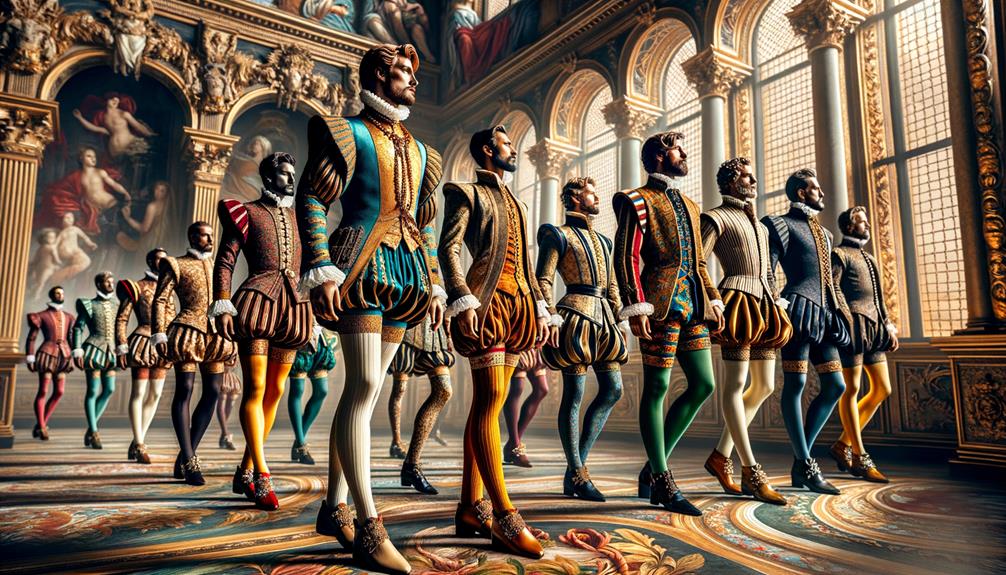
Hose and tights, a staple in the Renaissance man's wardrobe, added a pop of color and texture to his outfit. Men wore hose that were sewn together, except at the front, where laces secured them in place. This practical design, paired with the codpiece, which served both functional and decorative purposes, transformed basic leg coverings into a fashion statement.
Tights, crafted from fabrics like wool or silk, were often brightly colored or patterned. This choice wasn't just about aesthetics; it reflected the wearer's status and taste. The varied textures and colors of these garments played a significant role in defining the silhouette.
Here's a quick look at the features:
| Item | Material | Purpose |
|---|---|---|
| Hose | Wool, Silk | Leg covering |
| Tights | Wool, Silk | Fashion, warmth |
| Codpiece | Various fabrics | Decorative, functional |
| Fastening | Laces | Secure fit |
| Patterns | Bright colors | Status symbol |
Renaissance men took pride in wearing these garments, seamlessly integrating them into their overall fashion. Each piece was a deliberate choice, reflecting the era's innovative spirit in attire. The interplay of fabrics and colors truly captured the essence of Renaissance men's fashion.
Accessories and Adornments
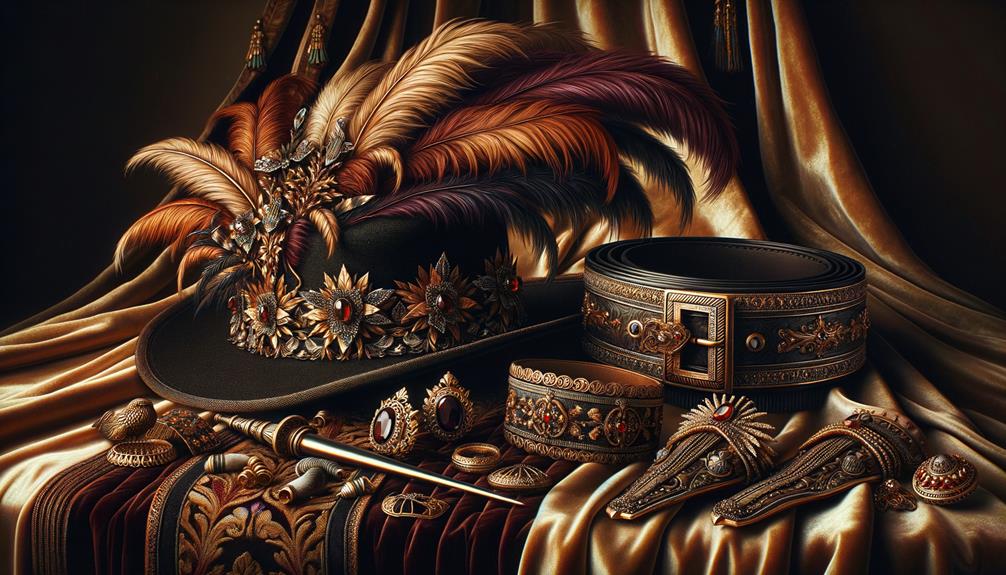
In Renaissance fashion, accessories and adornments revealed a lot about a person's social standing and personal style. The intricate details of these items speak volumes about the era's values and innovation.
Men used accessories not just for functionality, but to showcase their wealth and status. For example, perfumed gloves served a dual purpose: they masked unpleasant odors and displayed one's affluence through the use of rare scents. Velvet caps embedded with gems added a touch of opulence, catching the light and the eyes of onlookers. Codpieces, though peculiar by modern standards, symbolized virility and power. These items weren't mere decorations but statements of identity.
Three notable accessories from the Renaissance include:
Perfumed gloves, a symbol of luxury and sophistication.
Velvet caps with gems, adding a flash of wealth and elegance.
Codpieces, boldly symbolizing masculinity and status.
Each accessory served to differentiate the aristocrats from the lower classes, turning fashion into a tool of influence. A man's choice of accessories, whether subtle or extravagant, illustrated his place in society and his personal style.
Footwear Styles
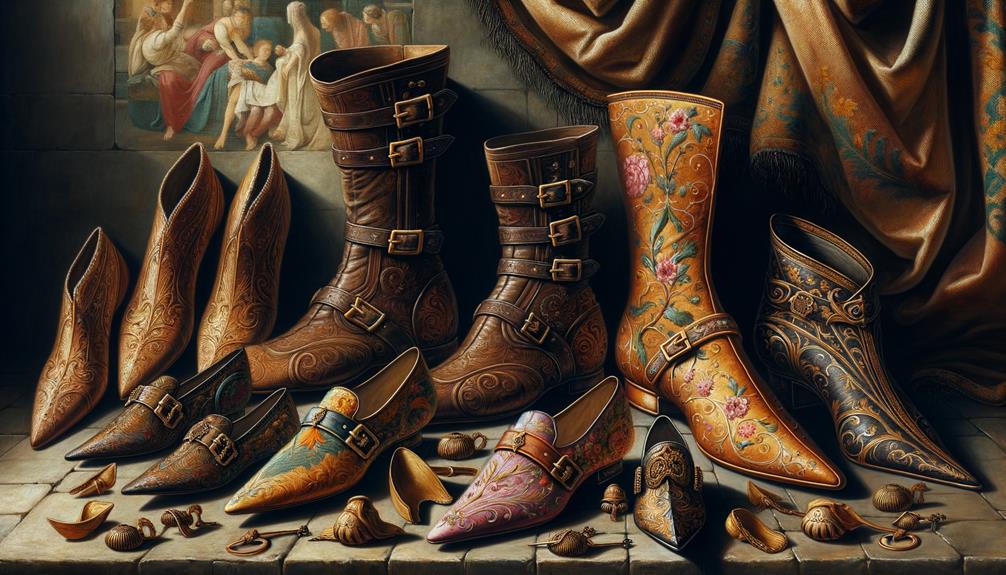
Renaissance men's footwear, reflecting both function and fashion, varied from simple slippers to elaborately decorated shoes. I find it fascinating how these shoes, though often essential, played a vital role in completing a man's ensemble. They were more than just protective gear; they were statements of style.
In this era, men's fashion emphasized balance. Footwear lacked the exaggerated toes seen in earlier periods, opting for more refined silhouettes. Sometimes, slashing was used to add a decorative touch. It's intriguing how these subtle details could elevate a look without overwhelming it.
Material and style choices were diverse. From sturdy leather for everyday wear to luxurious fabrics for special occasions, the variety was both practical and expressive. Each pair of shoes had a purpose, whether for comfort during long walks or for showcasing wealth at social gatherings.
What I appreciate most about Renaissance men's fashion is its thoughtfulness. Footwear wasn't just an afterthought. It was a calculated component of the entire outfit. This evolution in footwear styles not only mirrored the changing trends but also highlighted the period's innovative spirit. The Renaissance was, after all, a time of rebirth and creativity.
Influence of Royalty
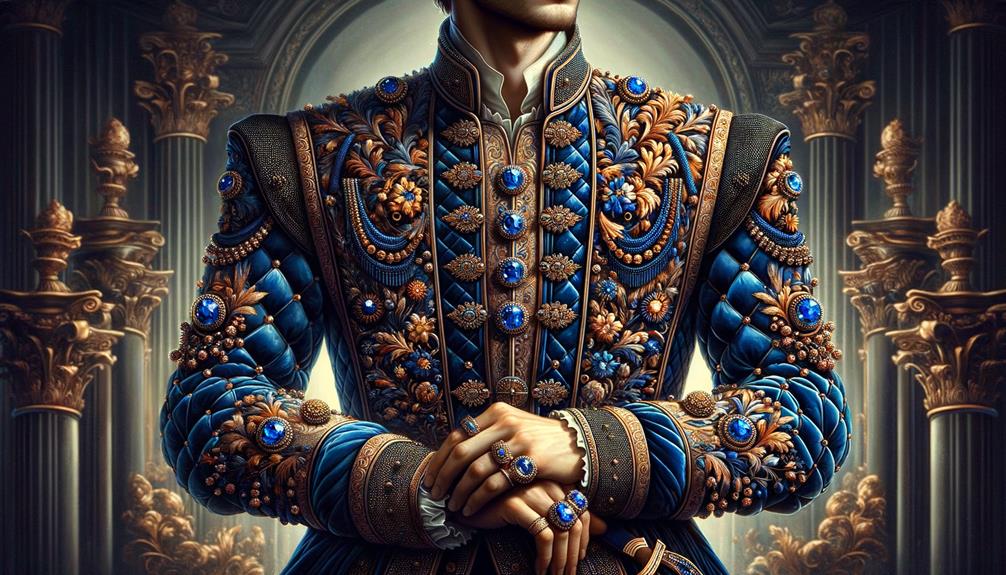
Royalty's fashion choices had a profound impact, shaping trends that extended far beyond the palace walls. Observing the attire of kings and queens offers a glimpse into the power dynamics of the Renaissance era. Their preference for elaborate hats, adorned with jewels and feathers, signified their royal status. These accessories weren't just for show; they communicated authority and opulence.
King Henry VIII played a pivotal role in setting the fashion standards. His signature stuffed doublets and slashed sleeves weren't merely garments; they were statements of power and wealth. His choices trickled down to the nobility, creating a ripple effect in sartorial preferences. The wide, billowy sleeves made from luxurious materials like satin, cotton, and velvet became the epitome of high fashion.
To understand the impact of royal fashion, consider the following:
- Luxurious fabrics: Materials like leather, silk, satin, velvet, and taffeta were reserved for the elite, signifying their wealth and status.
- Ornate accessories: Jewels and feathers on hats conveyed power and status, distinguishing the ruling class from the common people.
- Fashion statements: King Henry VIII's stuffed doublets and slashed sleeves set the standard for elite fashion, showcasing the royal family's influence on style.
These elements weren't just about aesthetics; they were about asserting dominance and influence. The royal wardrobe was more than clothing; it was a tool for maintaining and showcasing power.
Frequently Asked Questions
What Did Males Wear in the Renaissance?
During the Renaissance, men's fashion was characterized by linen shirts adorned with ruffs, fitted doublets, leather jerkins, and a variety of hose styles. Outerwear consisted of cloaks and capes. Hairstyles were diverse, and headgear became increasingly elaborate. The era's fashion was marked by a display of opulence and innovation.
What Was the Fashion Trend in the Renaissance?
In the 16th century, fashion was a status symbol, with men spending up to 70% of their income on clothing. The era's opulent fashion featured elaborate ruffs and intricate designs, showcasing individuality through richly detailed attire.
What Type of Wardrobe Did a Renaissance Man Wear?
Renaissance men commonly wore a unique combination of clothing, including linen shirts with ruffs, fitted doublets, and leather jerkins. They paired these with various styles of hose and stockings, finishing the look with flat shoes. To complete their outfit, they added cloaks, military jackets, and stylish headgear, creating a layered and innovative look.
What Did Men Wear in the 1570s?
Men's fashion in the 1570s featured fitted doublets with wrist ruffs, worn by about 70% of men. Outerwear favorites included short cloaks and capes. Hats came in various styles, from soft fabric to capotain designs. Hair was generally short, but slowly growing longer, marking a fascinating shift in style.



